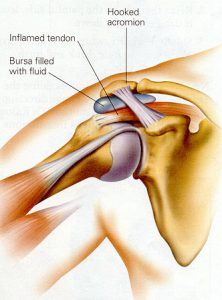30 Apr Why does it hurt to lie on my side?
Do you have pain in your upper arm when you lie on your side or attempt to lift above your head?
If so you may have a shoulder impingement…

The shoulder joint is a shallow ball and socket joint, which allows a lot of movement. However this decreases the stability of the joint. The rotator cuff refers to a group of muscles that are designed to hold the shoulder properly in place and help control its movement.
Correct positioning of the shoulder blade (scapula) is integral to shoulder movement, as it forms the socket of the joint. Scapula position is controlled by scapular stabilizing muscles (the trapezius, rhomboids and serratus anterior).
Impingement occurs when the gap between the top of the arm bone and the top of the shoulder blade is too small, causing pinching of structures such as the rotator cuff tendons and/or the bursa (a small bag of fluid designed to reduce friction between bone and tendons). If impingement becomes severe or has been left untreated for a long time, the rotator cuff tendons can become weak and tear.
Symptoms may include:
- Pain with certain shoulder movements (particularly lifting the arm to shoulder height)
- Difficulty sleeping on the affected side
- Aching pain in the upper arm
- Lack of strength in the arm
What PhysioFit can do to help:
- Correct muscle imbalances and improve movement patterns using specific strengthening and stretching exercises
- Manual therapy techniques to release tight muscles, improve blood flow, reduce pain/inflammation and aid healing of the rotator cuff tendons
- Taping to improve shoulder position and movement patterns
- Advice regarding management and activity avoidance to prevent ongoing injury
- Graduated return to daily activity and sport
- Post-surgical rehabilitation if necessary




